FILLONGLEY PUBS. Over the years, Fillongley has had a number of different public houses.
The 'post office' was formerly the Three Horse Shoes, and before that - a blacksmiths. Behind it, the little white cottage was also a beer house.
The BUTCHERS ARMS dates back to the 16th century. Has closed since 2000 and is now converted to a house. Was run by the Meek family in the early part of the 20th century.
THE MANOR HOUSE, in the centre of the village was once a 'house' and was converted into a 'pub' in the 1930's.
THE BELL INN, in the centre of the village next to the Manor House, was a public house run by Charles Barker and then his daughter, Maud. At the rear was a bowling green. It was also the first post office and bank in the village. Later it was run by Harry Hyland. See memories of living in the village at the Bell Inn below. The pub was closed in 1930's as the brewery bought the Manor House and turned it into a pub.
WEAVERS ARMS - located on the Nuneaton Road, Fillongley - still in use. Silk weaving was done in Fillongley.
THE COTTAGE INN - in Blackhall Lane - still in use.
THE DURHAM OX - Broad Lane, was closed as Lord Norton complained as he did not like the miners who sat outside 'whistling' at his daughters when they passed !
SARACENS HEAD - at Corley Ash, closed 2013. Converted into a house.

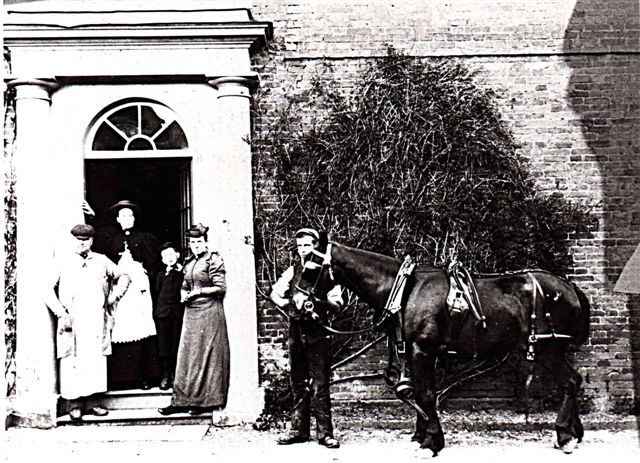
OUTSIDE THE MANOR HOUSE - before it was a 'pub.' TOM GILBERT (village butcher) Jane Wills. Arthur Wills. Fanny Reynolds. George Billington.
BELOW: THE MANOR HOUSE - before it was a 'pub.'

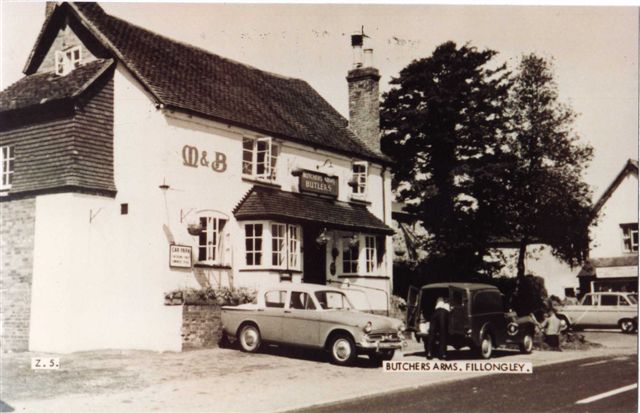
The Butcher's Arms was run by the Meek Family for many years
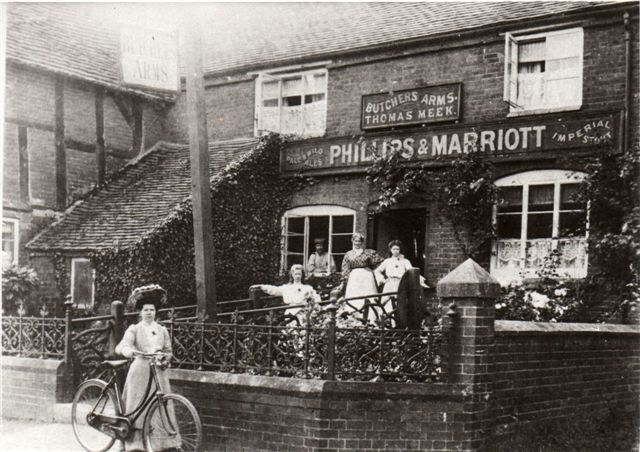

Above: The Butcher's Arms. Now converted into a house.
MEMORIES OF FILLONGLEY and the BELL INN
Written by Peg Hale (nee Bucknell) born 1922.
The slump of 1929 affected the family having lost their jobs at Daimler. 'Nunk' Harry Hyland, took over the Bell Inn in Fillongley. The pub was very old and there was no gas or electricity. Oil lamps had to be cleaned and lit at dusk, candles were used in the bedrooms where wash-hand stands and chamber pots were used. Cold water was on tap downstairs. At the side of the building was a large stone-floored room called the Brew House. We didn't brew but there was a large brick copper under which a fire was lit for wash day and we had a zinc tub and a dolly, which was made of wood with a long handle used for swishing the clothes around in the tub to clean them.
The pub had a long room we called the 'big smoke room', a public bar and at the rear, a small 'smoke room' for the posh people. To the side of the building was a men's lavatory which smelled. At the rear was a ladies toilet hidden by a thick hedge. The garden had a lawn with a walnut tree, a bowling green, a kitchen garden with a green house and at the bottom of the garden was a shallow clear stream. There were also outbuildings and stabling and a kennel for our dog, Roger, a water spaniel.
There was a sign outside the Bell Inn saying 'Ham and Egg Teas' which my mother, Sarah Bucknell cooked. One time, she cooked lots of pigeon pies for a group of people who ate in the long room over the brew house. Great hunks of bread and cheese were eaten and the cheese was kept in the brew house.
On the other side of the front courtyard was a butcher's shop and at the rear they slaughtered animals and the meat was sold in the shop. They also sold chitterlings, tripe, pig's feet and black pudding. As children we often helped to pull on a rope to force a cow to her doom where she would be killed with a pole axe. I didn't like it when they killed a pig as they always screamed when they had their throats cut. After sheep were killed their little legs were broken and they blew into them to loosen the skin which came off quite easily.
Fillongley School was at the top of the main street. We had chalks and small wood-edged slates. I don't remember learning much. In the classroom there was a big black stove with a guard we were allowed to hang wet clothes on. On the way to school we often stopped at the bakers. He lined the outside of the oven with strips of dough to make a seal and if we were lucky, we would be given the bread sticks to eat on the way to school.
There were few cars, maybe six in the whole area. Farmers had trucks and cars. We were lucky as Nunk did drive a car which he used to fill with us kids and take to Corley Rocks. There was only one bus a week into Coventry and bicycles were the main means of transport with oil lamps on them.
Men who lived in the village who weren't workin on the farms, were employed at a coal mine at Arley. On fine summer evenings they could be seen sitting on a stone wall outside their cottages, smoking and couhging.
At the end of the terrace of small cottages by us, was the shoemaker and repairer we called 'The Snob'. Mr Rathbone could be seen in the window of his shop with a mouthful of nails hammering away at a shoe.
----------------------
Memories written in 2006 by Peg Hale (nee Bucknell). Born 30th Jan 1923
FAMILY HISTORY
Harry Hyland (Nunk) born 13 March 1887 in Swindon, died 5 July 1957 in Bournemouth, while lodging with Sarah Bucknell.
Peg's mother: Sarah Bucknell born 9th March 1888.
Peg's sister: Kathleen Bucknell born 23 June 1924.
Harry Hyland (Nunk) worked at Daimler in Coventry with Wilfred Bucknell. Harry lodged at Wilfred and Sarah Bucknell's house in Radford, Coventry. When they both lost their jobs at Daimler in the 'great depression' of 1929, Sarah and Wilfred Bucknell and Harry Hyland moved to Fillongley and all lived and worked together at the Bell Inn with their two children, both fathered by Harry Hyland.
The barmaid (named Gwen) was replaced by a girl, Lucy Margaret Fellows, who lived in the adjacent cottages next to the Cobbler's Shop.
Harry Hyland and Lucy Fellows stayed together and had 6 children together. Lucy was born in 1912 and was 25 years younger than Harry. The children: Margaret Lucy, Herbert James, Joan, Trevor, Clive and Wendy. Eventually, Lucy Fellows went on to live with another partner.
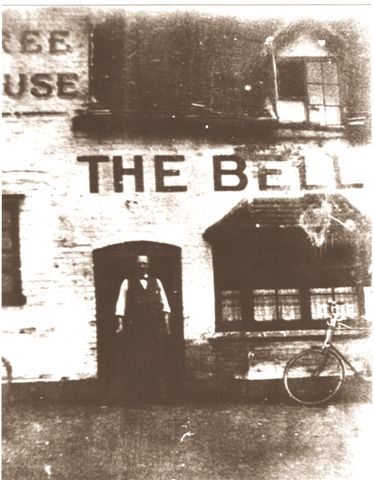
Mr Charles Barker ran the Bell Inn and had the first post office and bank in Fillongley

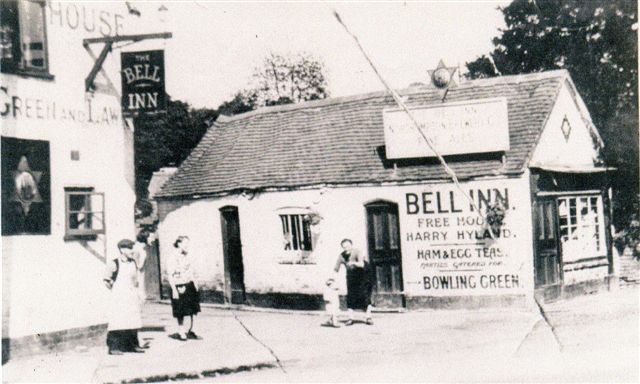
Mr Rathbone (cobbler and sadler) standing on left.
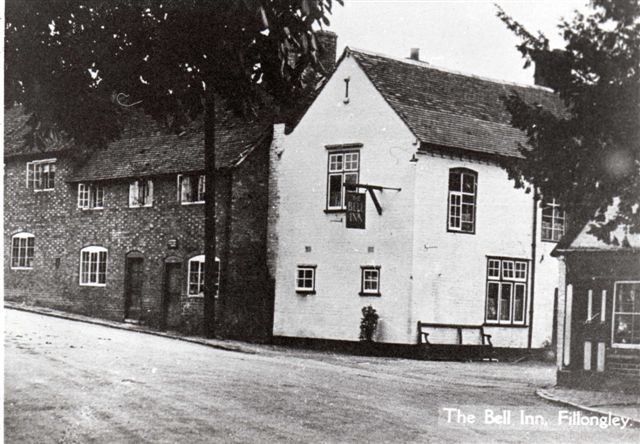

Bell Inn c1930s. The small Bournebrook Stream is culverted beneath the Coventry Road and in times of extreme weather sometimes becomes like a raging river and floods the lower village properties
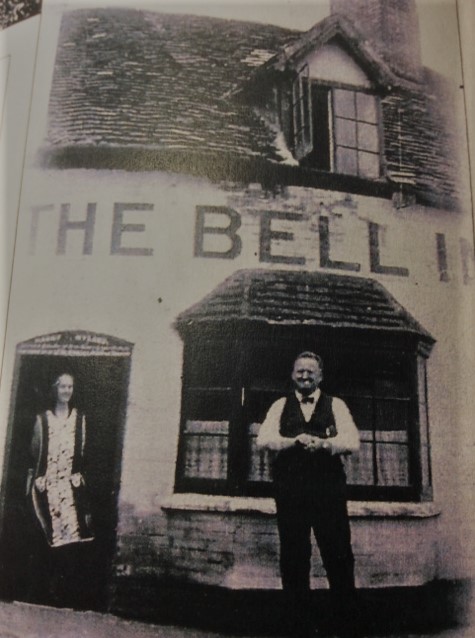
Peg Bucknell and Harry Hyland c1932
Harry Hyland returned to Fillongley in 1951 and became Chairman and Treasurer of the Fillongley Cricket Club
